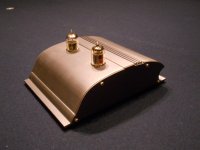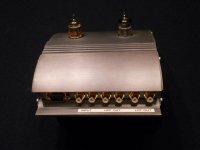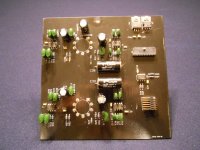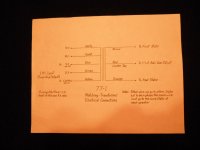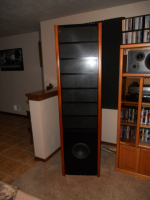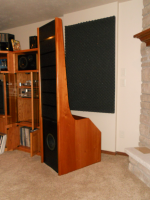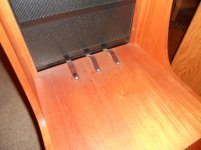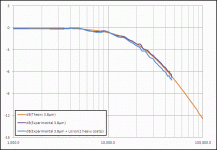The information from this forum is outstanding!
The 1996 literature from Lucas on their ESL step-up Xfmr says it is their "77-1" manufactured "especially for them by an American company, and of course it is much better than the Triad S-142a many others are using which is now out of production." The primary wires are brown, red (c/t) and orange. The secondaries are yellow (common), green (2 ohm), blue (4), violet (8) and white (16 ohm).The resistance between the orange/brown primaries is 8Kohm, FWIW.
Now that the mystery of the Interface is solved, I will probably take it out of the circuit anyway because my Jazzmans are cut off below 330hz and don't need any bass EQ. And, when I get the funds, I will probably upgrade with new toroid Xfmrs per Charlie and Jer and keep the Lucas Xfmr for the Lucas ESLs I still have.
The 1996 literature from Lucas on their ESL step-up Xfmr says it is their "77-1" manufactured "especially for them by an American company, and of course it is much better than the Triad S-142a many others are using which is now out of production." The primary wires are brown, red (c/t) and orange. The secondaries are yellow (common), green (2 ohm), blue (4), violet (8) and white (16 ohm).The resistance between the orange/brown primaries is 8Kohm, FWIW.
Now that the mystery of the Interface is solved, I will probably take it out of the circuit anyway because my Jazzmans are cut off below 330hz and don't need any bass EQ. And, when I get the funds, I will probably upgrade with new toroid Xfmrs per Charlie and Jer and keep the Lucas Xfmr for the Lucas ESLs I still have.
ESL Bi-Amp
Like everyone else it seems, I decided to go hybrid and bi-amp with my own line level electronic crossover at 300 Hz. Did the filters with Burr Brown OP2604's; 4 pole Bessel response (0% overshoot, constant group delay). There is a slight dip at Fc (<2dB), but no ringing on transients. I needed a little more gain for the tube amp that runs the panels, so the HPF has a 12AU7 SRPP output stage, the LPF uses another BB2604. I put the amp section in a housing I used for a GPS device in a former business and put the power supply in its own extrusion.
Like everyone else it seems, I decided to go hybrid and bi-amp with my own line level electronic crossover at 300 Hz. Did the filters with Burr Brown OP2604's; 4 pole Bessel response (0% overshoot, constant group delay). There is a slight dip at Fc (<2dB), but no ringing on transients. I needed a little more gain for the tube amp that runs the panels, so the HPF has a 12AU7 SRPP output stage, the LPF uses another BB2604. I put the amp section in a housing I used for a GPS device in a former business and put the power supply in its own extrusion.
Attachments
ESL Hybrids
Charlie-
Just checked out your website; very nicely done. Your instructions are a whole lot better than what came with the David Lucas kit.
To share some info about my build experience:
I had the perf panels custom made by Diamond Perforated Metal Products in Visalia CA, and I believe they have facilities in Chicago, Seattle, Denver, LA and Houston as well. I had them perf the metal sheet (18" x 48") with seven 6" x 16" windows. That left a nice un-perferated frame around the windows and the perimeter of the sheet to attach the 3M VHB tape. They have a minimum order size, so people may have to combine their requirements to get to that minimum, otherwise you end up with a lot of excess metal (I had ~50 sheets made for $1K). They shipped on a skid by truck and were VERY flat. Metal was 18 gauge steel, 0.127" holes on 0.188" centers which yielded 41.38% open area.
I had the panels powder coated and attached the electical connectors AFTERWARD by scaping off a 1" square area and used 2-part silver epoxy to attach the flat flex circuits to the metal work. I created my own flex circuits by sandwiching a strip of 0.003" stainless sheet (available from Small Parts FL) between 2 pcs of kapton tape with each of the pcs cut shorter on the ends to expose the SS strip at each end. This makes a nice flat 3/4" wide flexible conductor that is insulated to >5KV. The third conductor (to the diaphram) was similiarly epoxied to a 16" x 3/4" SS strip and contacted the conductive surface of the diapharm between the 3M tape, similar to your copper ring, but only along the bottom edge. I coated one side of the diaphram with graphite after tensioning, but before attachment to the stator. I found that a lot of mechanical tensioning was needed and as a final step (and to remove all wrinkles) using the heat gun treatment. If I tried to tension them using only heat, I found the panels would "relax" over time and sag, causing arcing.
The bass drivers are Scanspeak 25W/8565 10" woofers mounted in a 6½ cuft (17" x 27" x 26") MDF box with 4" x 9.33" vent. The sides and supporting frames for the panels are 3/4" mahogany.
I'm a recent convert (4 years ago) to ESL's and I'm not familiar with the Lucas speakers. Can you post a description and photos?
__________________
Jazzman's DIY Electrostatic Loudspeaker Page
Charlie-
Just checked out your website; very nicely done. Your instructions are a whole lot better than what came with the David Lucas kit.
To share some info about my build experience:
I had the perf panels custom made by Diamond Perforated Metal Products in Visalia CA, and I believe they have facilities in Chicago, Seattle, Denver, LA and Houston as well. I had them perf the metal sheet (18" x 48") with seven 6" x 16" windows. That left a nice un-perferated frame around the windows and the perimeter of the sheet to attach the 3M VHB tape. They have a minimum order size, so people may have to combine their requirements to get to that minimum, otherwise you end up with a lot of excess metal (I had ~50 sheets made for $1K). They shipped on a skid by truck and were VERY flat. Metal was 18 gauge steel, 0.127" holes on 0.188" centers which yielded 41.38% open area.
I had the panels powder coated and attached the electical connectors AFTERWARD by scaping off a 1" square area and used 2-part silver epoxy to attach the flat flex circuits to the metal work. I created my own flex circuits by sandwiching a strip of 0.003" stainless sheet (available from Small Parts FL) between 2 pcs of kapton tape with each of the pcs cut shorter on the ends to expose the SS strip at each end. This makes a nice flat 3/4" wide flexible conductor that is insulated to >5KV. The third conductor (to the diaphram) was similiarly epoxied to a 16" x 3/4" SS strip and contacted the conductive surface of the diapharm between the 3M tape, similar to your copper ring, but only along the bottom edge. I coated one side of the diaphram with graphite after tensioning, but before attachment to the stator. I found that a lot of mechanical tensioning was needed and as a final step (and to remove all wrinkles) using the heat gun treatment. If I tried to tension them using only heat, I found the panels would "relax" over time and sag, causing arcing.
The bass drivers are Scanspeak 25W/8565 10" woofers mounted in a 6½ cuft (17" x 27" x 26") MDF box with 4" x 9.33" vent. The sides and supporting frames for the panels are 3/4" mahogany.
Attachments
Last edited:
Vary good looking ESL setup....flat the best sounding to me...i have ML also.......thanks for the pic......
Do you find with your ear at the panel....that you lose ANy output as you move up the panels?...........are dose it have good output at the top?.....i find the bias......AN coating to be Vary inportant......Did you use any high V bias wire?
thanks
Do you find with your ear at the panel....that you lose ANy output as you move up the panels?...........are dose it have good output at the top?.....i find the bias......AN coating to be Vary inportant......Did you use any high V bias wire?
thanks
Vary good looking ESL setup....flat the best sounding to me...i have ML also.......thanks for the pic......
Do you find with your ear at the panel....that you lose ANy output as you move up the panels?...........are dose it have good output at the top?.....i find the bias......AN coating to be Vary inportant......Did you use any high V bias wire?
thanks
I agree, flat panels seem to sound better than curved. Between my David Lucas kit and these, I bought a pair of ML Requests; was never happy with them. Not much bass and the curved panels just lacked that breath-taking imaging, especially on female vocals and acoustic instruments.
I don't notice any difference between sound output from bottom to top. I made sure the graphite coating on the diaphram was uniform and fairly heavy; I used a cotton gauze bandage to smear it around until the mylar had an "even" gray sheen to it. Also, you want to vacuum the panel and work area extensively to clean up any graphite dust. Graphite powder is messy and you don't want it getting anywhere that you don't want conduction. A good way to measure the coating is with a couple of copper pennies and an ohm meter. Move the pennies around the panel spaced several inches apart and measure the resistance with the meter by touching the probes to the pennies; should be <100K for under 6" spacing.
The connection from the box to the panels is the flex cable I described; inside the box (from bias supply to flex cables) I used HV anode wire designed for TV CRTs.
As for your an all others.... ML panels are only half on.... So all the panels are rolled down.....thay were saleing panels at the time............i have re-worket the ML panels an ran new bias feeds..get 3-5db more output an bass match much better .......but i buy the R. Sandres Flat panel setup...low dispershion...
Funny other dont talk about graphite coating ?....I know David Lucas did .....We all know about it.... an i have used it mixet with outher coathing.....Vary ezzy to find... at Home dep...or lowes...it in small littel tubes at were Key are cut......where did you get your .graphite .....an do you know if there is diff types??......
Funny other dont talk about graphite coating ?....I know David Lucas did .....We all know about it.... an i have used it mixet with outher coathing.....Vary ezzy to find... at Home dep...or lowes...it in small littel tubes at were Key are cut......where did you get your .graphite .....an do you know if there is diff types??......
Last edited:
where did you get your .graphite .....an do you know if there is diff types??......
The graphite I used was the standard hardware store variety. I'm not aware if there are different types....
I used Graphite on the my very First panels in 2003, and, I have too tell Ya it was one big PIA!!!
It got everywhere and the only kind of coating I could get that would work had a low resistance.
I had quite a few diaphragms that would work at First and then fade away because the coating would come off and it would get all over the stators causing them to short out as well and the diaphragm would lose its charge.
The graphite I used I got in an art store at 10$ for a big bottle in the mid 80's and I still have it.
I now use it mixed with white glue to make my Graphite charge rings.
Shortly (about a month or two) after that Licron had just came out and I sent away for a sample can and they sent it to me and that is what I have been using ever since.
In fact I still have that very same can and it is still about half full.
jer
It got everywhere and the only kind of coating I could get that would work had a low resistance.
I had quite a few diaphragms that would work at First and then fade away because the coating would come off and it would get all over the stators causing them to short out as well and the diaphragm would lose its charge.
The graphite I used I got in an art store at 10$ for a big bottle in the mid 80's and I still have it.
I now use it mixed with white glue to make my Graphite charge rings.
Shortly (about a month or two) after that Licron had just came out and I sent away for a sample can and they sent it to me and that is what I have been using ever since.
In fact I still have that very same can and it is still about half full.
jer
Thanks jer............
Funny some say the Licron works great....others say not so much??
I know you are into smaller panels .........is that right?
john65b used Licron on his lager CLS panels...i am not saying there were not other prob...not sure it worket that well...
looks like it works for the jazzman...
I have not been useing new Mylar on any of my re-worket ML panels...so i can say what would best....
Calvin says.......
My clear transparent Tesa recipe coating (PVA-Glue or similar) still works after >>10years on one of my oldest panels, which I get every now and then out of the wet damp garage into the living room. Apart from the different climatic situation under which Wachara suffers, this seems to be the single most important difference, defining fail or success.
The only drawback of tis coating seems to be to find the right glue
thanks for all an any info on ESLs.........
Funny some say the Licron works great....others say not so much??
I know you are into smaller panels .........is that right?
john65b used Licron on his lager CLS panels...i am not saying there were not other prob...not sure it worket that well...
looks like it works for the jazzman...
I have not been useing new Mylar on any of my re-worket ML panels...so i can say what would best....
Calvin says.......
My clear transparent Tesa recipe coating (PVA-Glue or similar) still works after >>10years on one of my oldest panels, which I get every now and then out of the wet damp garage into the living room. Apart from the different climatic situation under which Wachara suffers, this seems to be the single most important difference, defining fail or success.
The only drawback of tis coating seems to be to find the right glue
thanks for all an any info on ESLs.........
I think a lot of the problems that most are having with licron is that they are trying to use it too sparingly.
The Crystal version is extremely thin as it is and a few have tried to thin it even more.
This can cause an inconsistencies in the resistance of the coating causing it to have too high of a resistance.
It is also possible that some are not applying enough around the perimeter of the panel to insure proper contact to the contacts or charge rings.
I have had a few times it not work properly but reapplying a second coat fixed it every time.
Because it is a spray you have to mask off the perimeter, I use sheets of printer paper with one edge sprayed with 3M's sticky glue in a can as you can stick it to the mylar once or twice (is about it) without damaging or gooping up the mylar.
And give the complete perimeter one good coat after the whole panel has been coated.
I have found that I don't even need charge ring but I do incorporate one for good measure.
This may be a very different story for a much larger panel.
Trying to coat Mylar is a art within it self as nothing sticks to it and anything that is applied to it tends to bead up and this can be difficult to keep up with on a larger panel as it flashes so quickly.
I have experimented with PVA glues but I have yet to coat a Diaphragm for use with it.
I have not yet located the equivalent brand of Calvin "Tesa" brand glue but I keep my eyes open for it or anything that maybe more affordable than Licron.
I am going to give Turtle Wax product a try sometime as well.
It has been shown that PCA glues don't fair well in high humidity area's either but this could be a type of, or brand issue as well.
I only of very few to chose from here in the states and those are Elmer's and TightBond.
In my test with using PVA Glues I found the beading up of the coating was a big problem as can be with using Licron as well.
With Licron I just swabbed it around, although this can cause a bit of cloudiness as mentioned in another thread.
But this doesn't really bother me anyhow.
With the water based PVA glue trick I had to add a surfactant in order to keep it from beading up.
A few drops of Dawn Dish Detergent added to the solution was all that was needed and I was able to apply it to my sample without it beading up.
I was also using a much thinner mix ratio of about 8 or 10:1 water/glue.
My thoughts on adding some dish soap may also help with the resistance of the coating as it contains Sodium lauryl sulfate and this is the main ingredient that has been found to be the active component when using dish soap as a coating.
There are a few different types of PVA glues out there, some are more permanent and some that will soften up as it sits in water over a period of time.
I will try this technique soon when I finish my next panel but it is hard to change from a product that I know that works perfectly for me.
As I mentioned, I still have about a half can of Licron and nearly a full can of Crystal.
The Licron coating has passed a most grueling environmental test that any panel shall ever see and it worked the very first time I hooked it up without taking the panel apart after 7 years of such abuse.
I know there are some clear glues made for school kids and I wonder if this might be the same stuff as the Tesa brand glue?
jer
The Crystal version is extremely thin as it is and a few have tried to thin it even more.
This can cause an inconsistencies in the resistance of the coating causing it to have too high of a resistance.
It is also possible that some are not applying enough around the perimeter of the panel to insure proper contact to the contacts or charge rings.
I have had a few times it not work properly but reapplying a second coat fixed it every time.
Because it is a spray you have to mask off the perimeter, I use sheets of printer paper with one edge sprayed with 3M's sticky glue in a can as you can stick it to the mylar once or twice (is about it) without damaging or gooping up the mylar.
And give the complete perimeter one good coat after the whole panel has been coated.
I have found that I don't even need charge ring but I do incorporate one for good measure.
This may be a very different story for a much larger panel.
Trying to coat Mylar is a art within it self as nothing sticks to it and anything that is applied to it tends to bead up and this can be difficult to keep up with on a larger panel as it flashes so quickly.
I have experimented with PVA glues but I have yet to coat a Diaphragm for use with it.
I have not yet located the equivalent brand of Calvin "Tesa" brand glue but I keep my eyes open for it or anything that maybe more affordable than Licron.
I am going to give Turtle Wax product a try sometime as well.
It has been shown that PCA glues don't fair well in high humidity area's either but this could be a type of, or brand issue as well.
I only of very few to chose from here in the states and those are Elmer's and TightBond.
In my test with using PVA Glues I found the beading up of the coating was a big problem as can be with using Licron as well.
With Licron I just swabbed it around, although this can cause a bit of cloudiness as mentioned in another thread.
But this doesn't really bother me anyhow.
With the water based PVA glue trick I had to add a surfactant in order to keep it from beading up.
A few drops of Dawn Dish Detergent added to the solution was all that was needed and I was able to apply it to my sample without it beading up.
I was also using a much thinner mix ratio of about 8 or 10:1 water/glue.
My thoughts on adding some dish soap may also help with the resistance of the coating as it contains Sodium lauryl sulfate and this is the main ingredient that has been found to be the active component when using dish soap as a coating.
There are a few different types of PVA glues out there, some are more permanent and some that will soften up as it sits in water over a period of time.
I will try this technique soon when I finish my next panel but it is hard to change from a product that I know that works perfectly for me.
As I mentioned, I still have about a half can of Licron and nearly a full can of Crystal.
The Licron coating has passed a most grueling environmental test that any panel shall ever see and it worked the very first time I hooked it up without taking the panel apart after 7 years of such abuse.
I know there are some clear glues made for school kids and I wonder if this might be the same stuff as the Tesa brand glue?
jer
Last edited:
Just want to add my .02$ to the graphite/Licron debate. My Lucas ESLs were made with hardware-store graphite applied per Lucas' instructions. My 4 2' x 3' panels still work after 16+ years. The trick to applying graphite is to use a very small amount and rub it in with a gauze pad until it turns to a sheen. It is necessary to do this one 4-6" square spot at a time (so if you have a 1' x 4' panel, for example, you lay the mylar down on a piece of white paper marked off in a grid and apply the graphite using the grid as a guide.) Do each square one at a time. Vacuum it off to get any loose graphite and that is it. No need to measure resistance. The Lucas ESLs do not use a charge ring unlike Jazzman method, btw. I've never had a problem with graphite flaking off, and so far they have resisted arcing better than the Jazzmans. The Lucas ESLs, with the Lincane gold-anodized aluminum panels, have only one coat of Rustoleum gloss black on them. My Jazzmans, also with one coat, have experienced some arcing problems probably due to the thin insulation of one coat of paint, and maybe the Licron was sprayed on too thick. I'm going to rebuild them and re-paint the panels following Jer's recommendations (i.e. coats of primer, base color, and many coats of gloss clear.) Although it is pricey, Licron is easy to apply and thus quicker than graphite , of course, but I was surprised with the arcing I've been getting despite the Jazzman's 21st century technology...I'm just saying....
Anodized Aluminium is a great base as an insulator and probably why you have had such good luck with only using one coat of paint.
Basically it is a coating of Saphire on the surface as it is AL2 O3.
I have been thinking about methods to incorporate this into my wire mesh design as it is quite simple to do anodizing.
Although I do etch the wire mesh before I coat them in a Lye solution.
I found that this helps with the adhesion of the paints due to a rougher surface and also removes the saphire coating allowing for better conductivity between the wires in the mesh as a whole, so it might be better suited for plate material.
I have had in some case the poor conductivity between wire a problem as only a few of them are used to energize the whole stator
It was suggested in David P. Hermeyer's High Efficiency ESL design found in the Audio Amateur Speaker Builder magazine/handbook to have the perforated aluminium plates he used anodized.
I found the Home Depot now carry's some small pieces of Lincane and I was considering on trying those for my smaller panels sometime, however they are still a bit pricey.
There was a shop here in town that had a few pieces of some 48" stuff and I should have got it when I had the chance but he still wanted like $32 to $40 or so a piece for them and that was in 2003.
The arcing issue that you are having is not caused from the diaphragm coating being to thick but from the stator coating being to thin.
If anything the higher resistance that Licron has to offer has saved your diaphragm from holes being burned in it from not allowing a lot of current to flow when an arc does occur.
I did get the graphite to work, I just didn't care for the mess it can cause.
Roger sanders had some very good and interesting things to say about the reasoning that graphite may be a better thing to use as a coating when it comes to charge leakage in to the air.
But research has been shown in these threads that a higher resistance coating on the diaphragm results in a lower THD figures especially for the lowest frequency's due to less charge migration on the diaphragm.
I couldn't get a consistently workable coating up in the >1megohm range it was always less than that, But it did work.
In order to make it stick I had to rub it in very hard and this always produced a lower resistance than what I was aiming for.
It was when I tried to form a high resistance coating when I found that it would eventually come off of the panel and it would stop working all together.
jer
Basically it is a coating of Saphire on the surface as it is AL2 O3.
I have been thinking about methods to incorporate this into my wire mesh design as it is quite simple to do anodizing.
Although I do etch the wire mesh before I coat them in a Lye solution.
I found that this helps with the adhesion of the paints due to a rougher surface and also removes the saphire coating allowing for better conductivity between the wires in the mesh as a whole, so it might be better suited for plate material.
I have had in some case the poor conductivity between wire a problem as only a few of them are used to energize the whole stator
It was suggested in David P. Hermeyer's High Efficiency ESL design found in the Audio Amateur Speaker Builder magazine/handbook to have the perforated aluminium plates he used anodized.
I found the Home Depot now carry's some small pieces of Lincane and I was considering on trying those for my smaller panels sometime, however they are still a bit pricey.
There was a shop here in town that had a few pieces of some 48" stuff and I should have got it when I had the chance but he still wanted like $32 to $40 or so a piece for them and that was in 2003.
The arcing issue that you are having is not caused from the diaphragm coating being to thick but from the stator coating being to thin.
If anything the higher resistance that Licron has to offer has saved your diaphragm from holes being burned in it from not allowing a lot of current to flow when an arc does occur.
I did get the graphite to work, I just didn't care for the mess it can cause.
Roger sanders had some very good and interesting things to say about the reasoning that graphite may be a better thing to use as a coating when it comes to charge leakage in to the air.
But research has been shown in these threads that a higher resistance coating on the diaphragm results in a lower THD figures especially for the lowest frequency's due to less charge migration on the diaphragm.
I couldn't get a consistently workable coating up in the >1megohm range it was always less than that, But it did work.
In order to make it stick I had to rub it in very hard and this always produced a lower resistance than what I was aiming for.
It was when I tried to form a high resistance coating when I found that it would eventually come off of the panel and it would stop working all together.
jer
Last edited:
Hey guys, I have used Licron, but did not like the haze it left. In the last panel I refurbed, I just used hand soap....(Sodium Laurate?)....went on clear. But a simple rinse will remove it - wish I could have the soap more permanent, or the Licron clear.
Can really notice a sound quality difference between the two...
Haven't really tried anything else...
Can really notice a sound quality difference between the two...
Haven't really tried anything else...
I've built three sets of panels with Licron Crystal applied in one coat "just wet" and they all worked perfectly and the panels have very high output. One set turned out cloudy looking, though; which I attribute to applying the Licron on a rainy/humid day.
As Jer said, I think people get into trouble when they try to thin it down. It's already 98% volatile solvents and one wet coat is barely 2-microns thick... certainly not adding enough mass to fret about.
As Jer said, I think people get into trouble when they try to thin it down. It's already 98% volatile solvents and one wet coat is barely 2-microns thick... certainly not adding enough mass to fret about.
One set turned out cloudy looking, though; which I attribute to applying the Licron on a rainy/humid day.... It's already 98% volatile solvents and one wet coat is barely 2-microns thick... certainly not adding enough mass to fret about.
My experience mirrors your...as long as humidity is low and you apply a wet coat, Licron Crystal dries clear.
I measured the impact of adding two thick coats of Lycron on a 3.8µm diaphragm.
The added mass was equivalent to adding about 0.4µm to the thickness of the Mylar diaphragm.
Insignificant.
If interested, I had posted results for other diaphragm thicknesses here:
http://www.diyaudio.com/forums/plan...tatic-speakers-microphones-5.html#post3427260
Attachments
Did you use Licron or Crystal ?
I have not found any significant difference's as well.
Only slightly (maybe) as the Original Licron is much thicker when 2 or 3 coats are apllied .
I get nearly the same thickness of my .25mil (closer to .3mil after it has been heat treated) mylar, at about .6 mil for the total thickness using the original Licron.
With Crystal I can't measure the single layer thickness with just my micrometer.
FWIW, as not to confuse anyone because there are 2 products to choose from.
Anyhow, Great Info!!!!
jer
I have not found any significant difference's as well.
Only slightly (maybe) as the Original Licron is much thicker when 2 or 3 coats are apllied .
I get nearly the same thickness of my .25mil (closer to .3mil after it has been heat treated) mylar, at about .6 mil for the total thickness using the original Licron.
With Crystal I can't measure the single layer thickness with just my micrometer.
FWIW, as not to confuse anyone because there are 2 products to choose from.
Anyhow, Great Info!!!!
jer
Last edited:
Did you use Licron or Crystal ?
I used Licron Crystal, product code 1756 as shown here:
http://www.diyaudio.com/forums/planars-exotics/109789-esl-diaphragm-coating-20.html#post1942380
The original Licron was product code 1755.
- Status
- This old topic is closed. If you want to reopen this topic, contact a moderator using the "Report Post" button.
- Home
- Loudspeakers
- Planars & Exotics
- David Lucas ESL
